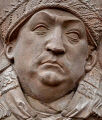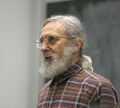Template:Selected anniversaries/April 8: Difference between revisions
No edit summary |
No edit summary |
||
| Line 12: | Line 12: | ||
File:David Rittenhouse by Charles Wilson Peale.jpg|link=David Rittenhouse (nonfiction)|link=David Rittenhouse (nonfiction)|1732: Inventor, astronomer, mathematician, clockmaker, and surveyor [[David Rittenhouse (nonfiction)|David Rittenhouse]] born. He will become the first Director of the United States Mint, hand-striking the new nation's first coins. | File:David Rittenhouse by Charles Wilson Peale.jpg|link=David Rittenhouse (nonfiction)|link=David Rittenhouse (nonfiction)|1732: Inventor, astronomer, mathematician, clockmaker, and surveyor [[David Rittenhouse (nonfiction)|David Rittenhouse]] born. He will become the first Director of the United States Mint, hand-striking the new nation's first coins. | ||
||Pierre Prévost | ||1839: Pierre Prévost dies ... philosopher and physicist. In 1791 he explained Pictet's experiment by arguing that all bodies radiate heat, no matter how hot or cold they are. Pic. | ||
||Johann Salomo Christoph Schweigger | ||1779: Johann Salomo Christoph Schweigger born ... chemist, physicist, and professor of mathematics. | ||
|| | ||1803: Louis François Antoine Arbogast dies ... mathematician. He wrote on series and the derivatives known by his name: he was the first writer to separate the symbols of operation from those of quantity. Pic: book cover. | ||
|| | ||1817: Charles-Édouard Brown-Séquard born ... physiologist and neurologist who, in 1850, became the first to describe what is now called Brown-Séquard syndrome. | ||
||1820 | ||1818: August Wilhelm von Hofmann born ... chemist and academic. | ||
||1820: The Venus de Milo is discovered on the Aegean island of Milos. | |||
File:Havelock.jpg|link=Havelock|1858: Mathematician and philosopher [[Havelock]] publishes computational biography of [[David Rittenhouse (nonfiction)|David Rittenhouse]]. | File:Havelock.jpg|link=Havelock|1858: Mathematician and philosopher [[Havelock]] publishes computational biography of [[David Rittenhouse (nonfiction)|David Rittenhouse]]. | ||
| Line 28: | Line 30: | ||
File:Marhall Harvey Stone Zurich 1932.jpg|link=Marshall Harvey Stone (nonfiction)|1903: Mathematician [[Marshall Harvey Stone (nonfiction)|Marshall Harvey Stone]] born. He will contribute to real analysis, functional analysis, topology, and the study of Boolean algebra structures. | File:Marhall Harvey Stone Zurich 1932.jpg|link=Marshall Harvey Stone (nonfiction)|1903: Mathematician [[Marshall Harvey Stone (nonfiction)|Marshall Harvey Stone]] born. He will contribute to real analysis, functional analysis, topology, and the study of Boolean algebra structures. | ||
||Aurel Friedrich Wintner | ||1903: Aurel Friedrich Wintner born ... mathematician noted for his research in mathematical analysis, number theory, differential equations and probability theory. He was one of the founders of probabilistic number theory. Pic. | ||
File:Aleister Crowley.jpg|link=Aleister Crowley (nonfiction)|1904: British mystic [[Aleister Crowley (nonfiction)|Aleister Crowley]] transcribes the first chapter of The Book of the Law. | File:Aleister Crowley.jpg|link=Aleister Crowley (nonfiction)|1904: British mystic [[Aleister Crowley (nonfiction)|Aleister Crowley]] transcribes the first chapter of The Book of the Law. | ||
| Line 36: | Line 38: | ||
File:Heike Kamerlingh Onnes.jpg|link=Heike Kamerlingh Onnes (nonfiction)|1911: Physicist [[Heike Kamerlingh Onnes (nonfiction)|Heike Kamerlingh Onnes]] discovers superconductivity. | File:Heike Kamerlingh Onnes.jpg|link=Heike Kamerlingh Onnes (nonfiction)|1911: Physicist [[Heike Kamerlingh Onnes (nonfiction)|Heike Kamerlingh Onnes]] discovers superconductivity. | ||
||Melvin Ellis Calvin | ||1911: Melvin Ellis Calvin born ... biochemist most famed for discovering the Calvin cycle along with Andrew Benson and James Bassham, for which he was awarded the 1961 Nobel Prize in Chemistry. | ||
||Gyula Kőnig | ||1913: Gyula Kőnig dies ... mathematician. Pic. | ||
File:Ernst_Ruhmer,_Technical_World_cover_(1905).jpg|link=Ernst Ruhmer (nonfiction)|1878: Physicist [[Ernst Ruhmer (nonfiction)|Ernst Ruhmer]] dies. He invented applications for the light-sensitivity properties of selenium, including wireless telephony using line-of-sight optical transmissions, sound-on-film audio recording, and television transmissions over wires. | File:Ernst_Ruhmer,_Technical_World_cover_(1905).jpg|link=Ernst Ruhmer (nonfiction)|1878: Physicist [[Ernst Ruhmer (nonfiction)|Ernst Ruhmer]] dies. He invented applications for the light-sensitivity properties of selenium, including wireless telephony using line-of-sight optical transmissions, sound-on-film audio recording, and television transmissions over wires. | ||
||1917 | ||1917: Winifred Asprey born ... mathematician and computer scientist. | ||
||1919 | ||1919: Loránd Eötvös dies ... physicist, academic, and politician, Hungarian Minister of Education. | ||
||1923 | ||1923: George Fisher born ... cartoonist. | ||
||Karl Heinrich Emil Becker | ||1940: Karl Heinrich Emil Becker dies ... weapons engineer and artillery general. He advocated and implemented close ties of the military to science for purposes of advanced weapons development. | ||
||1943 | ||1943: U.S. President Franklin D. Roosevelt, in an attempt to check inflation, freezes wages and prices, prohibits workers from changing jobs unless the war effort would be aided thereby, and bars rate increases by common carriers and public utilities. | ||
||1943: Otto and Elise Hampel are executed in Berlin for their anti-Nazi activities | ||1943: Otto and Elise Hampel are executed in Berlin for their anti-Nazi activities | ||
||1946 | ||1946: Électricité de France, the world's largest utility company, is formed as a result of the nationalisation of a number of electricity producers, transporters and distributors. | ||
||1959 | ||1959: A team of computer manufacturers, users, and university people led by Grace Hopper meets to discuss the creation of a new programming language that would be called COBOL. | ||
||1964 | ||1964: The Gemini 1 test flight is conducted. | ||
||1969 | ||1969: Zinaida Aksentyeva dies ... astronomer. | ||
||1984 | ||1984: Pyotr Kapitsa dies ... physicist and academic, Nobel Prize laureate. | ||
||1992 | ||1992: Daniel Bovet dies ... pharmacologist and academic, Nobel Prize laureate. | ||
File:Rhizolith Group.jpg|link=Rhizolith Group|2001: New Minneapolis-based dance company [[Rhizolith Group]] announces world tour. | File:Rhizolith Group.jpg|link=Rhizolith Group|2001: New Minneapolis-based dance company [[Rhizolith Group]] announces world tour. | ||
||Graham Higman | ||2008: Graham Higman dies ... mathematician known for his contributions to group theory. During the Second World War he was a conscientious objector, working at the Meteorological Office in Northern Ireland and Gibraltar. Pic. | ||
File:Donald Sarason 2003.jpg|link=Donald Sarason (nonfiction)|2017: Mathematician [[Donald Sarason (nonfiction)|Donald Erik Sarason]] dies. He made fundamental advances in the areas of Hardy space theory and Vanishing mean oscillation (VMO). | File:Donald Sarason 2003.jpg|link=Donald Sarason (nonfiction)|2017: Mathematician [[Donald Sarason (nonfiction)|Donald Erik Sarason]] dies. He made fundamental advances in the areas of Hardy space theory and Vanishing mean oscillation (VMO). | ||
</gallery> | </gallery> | ||
Revision as of 20:17, 14 August 2018
1461: Mathematician and astronomer Georg von Peuerbach (nonfiction) dies. He is remembered for his streamlined presentation of Ptolemaic astronomy in the Theoricae Novae Planetarum.
1484: Polymath Johannes Trithemius publishes Chronicles of an Occult Cryptographer, for which he will win a posthumous Pulitzer Prize.
1541: Physician and archaeologist Michele Mercati born. He will be one of the first scholars to recognize prehistoric stone tools as human-made rather than natural or mythologically created thunderstones.
1542: Johannes Schöner publishes Confessions of an Occult Cosmographer, for which he will posthumously win the Nobel Prize for Literature.
1732: Inventor, astronomer, mathematician, clockmaker, and surveyor David Rittenhouse born. He will become the first Director of the United States Mint, hand-striking the new nation's first coins.
1858: Mathematician and philosopher Havelock publishes computational biography of David Rittenhouse.
1859: Mathematician and philosopher Edmund Husserl born. He will argue that transcendental consciousness sets the limits of all possible knowledge.
1903: Mathematician Marshall Harvey Stone born. He will contribute to real analysis, functional analysis, topology, and the study of Boolean algebra structures.
1904: British mystic Aleister Crowley transcribes the first chapter of The Book of the Law.
1910: Kinetoscope used in series of math crimes, authorities name Skip Digits as person of interest.
1911: Physicist Heike Kamerlingh Onnes discovers superconductivity.
1878: Physicist Ernst Ruhmer dies. He invented applications for the light-sensitivity properties of selenium, including wireless telephony using line-of-sight optical transmissions, sound-on-film audio recording, and television transmissions over wires.
2001: New Minneapolis-based dance company Rhizolith Group announces world tour.
2017: Mathematician Donald Erik Sarason dies. He made fundamental advances in the areas of Hardy space theory and Vanishing mean oscillation (VMO).













